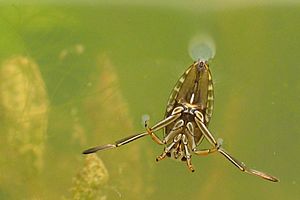Nepomorpha facts for kids
Quick facts for kids Nepomorpha |
|
|---|---|
 |
|
| Nepa cinerea, a water scorpion | |
| Scientific classification |
|
| Kingdom: | Animalia |
| Phylum: | Arthropoda |
| Class: | Insecta |
| Order: | Hemiptera |
| Suborder: | Heteroptera |
| Infraorder: | Nepomorpha Popov (1968) |
| Superfamilies | |
|
Aphelocheiroidea |
|
| Synonyms | |
|
Cryptocerata |
|
Nepomorpha is a special group of insects. They are part of the "true bug" order called Hemiptera. These insects are also known as true water bugs because they live mostly in water. You can find them all over the world, except in the very cold polar regions. There are about 2,000 different kinds of Nepomorpha species!
Nepomorpha bugs are unique because they have very small or missing simple eyes, called ocelli. Also, their antennae (feelers) are small and usually hidden close to their heads. This is why they were once called "Cryptocerata," which means "hidden-horned ones."
Most of these insects live in freshwater places like ponds and rivers. However, some, like the Ochteroidea, live right at the water's edge. Many Nepomorpha are predators. They hunt smaller animals without backbones, called invertebrates. Big water bugs, like water scorpions and giant water bugs, can even catch small fish and amphibians! Other Nepomorpha eat both plants and animals (they are omnivores) or just plants.
All Nepomorpha have special mouthparts that form a rostrum. This is like a straw they use to pierce their food and suck out liquids. Some, like the Corixidae, can even chew their food a little before sucking it up. Be careful, though! Some water bugs can use their rostrum to sting if they feel threatened. For example, the common backswimmer (Notonecta glauca) can give a sting that hurts more than a bee's sting!
Contents
How Water Bugs Evolved
Scientists believe the Nepomorpha first appeared about 250 million years ago. This was at the start of the Early Triassic period. Fossils show that by the end of the Triassic period, about 201 million years ago, most of the main groups (superfamilies) of water bugs we see today had already formed. Many fossil water bugs have been found. Most of them can be placed into the same groups that exist today.
Scientists have studied the family tree of Nepomorpha using DNA and how the bugs look (their morphology). This has helped them understand how these groups are related. The main groups (superfamilies) are all "monophyletic," meaning they all came from a single ancestor.
Here are some of the main superfamilies of Nepomorpha, from the oldest to the most recent:
- †Morrisonnepa (This is a very old fossil bug from about 151 million years ago.)
Nepoidea
- Family Belostomatidae – These are the giant water bugs.
- Family Nepidae – These are the water scorpions.
Corixoidea
- Family Corixidae – These are known as water boatmen.
Ochteroidea
- Family Gelastocoridae – These are called toad bugs.
- Family Ochteridae – These are velvety shore bugs.
Aphelocheiroidea
- Family Aphelocheiridae
- Family Potamocoridae
Naucoroidea
- Family Naucoridae – These are creeping water bugs.
Notonectoidea
- Family Notonectidae – These are the backswimmers.
Pleoidea
- Family Helotrephidae
- Family Pleidae – These are pygmy backswimmers.
See also
 In Spanish: Nepomorpha para niños
In Spanish: Nepomorpha para niños


